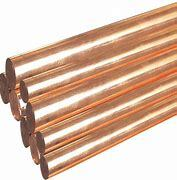1. Introduction
Copper is one of the most versatile metals in industrial and residential applications—thanks to its excellent conductivity, corrosion resistance, and malleability. Among its many forms, the copper rod stands out as a foundational material used across electrical grounding, welding, plumbing, and manufacturing. But not all copper rods are created equal. From copper earth rods to copper brazing rods and round copper bars, each type serves a distinct purpose. In this guide, we’ll break down seven essential copper rod and strip categories, compare their uses, and help you understand what drives copper rod price and copper strip price in today’s market.

2. Copper Rods for Earthing and Grounding
When it comes to safety in electrical systems, earthing is non-negotiable. That’s where copper earth rods—also called earthing rod copper or ground rod copper—come into play. Pure copper rods offer superior conductivity and longevity but can be expensive. As a cost-effective alternative, many opt for copper bonded earthing rods or copper clad steel ground rods. These combine a steel core for strength with a copper coating (typically 0.25mm or more) for conductivity.
- Copper bonded steel provides mechanical strength while maintaining good corrosion resistance.
- Copper clad earth rods are ideal for high-resistivity soils and offer a balance between performance and earthing rod price.
- Always verify compliance with local standards (like IEEE 80 or IEC 62561) when selecting an earthing solution.
3. Copper Rods for Welding and Brazing
Welding copper demands specialized materials due to its high thermal conductivity. For joining copper to copper, professionals often use copper to copper brazing rods or copper welding rods designed specifically for this purpose. Copper rod for welding typically contains phosphorus or silver alloys to lower melting points and improve flow.
Copper brazing rod types include:

- Phosphorus-copper alloys (ideal for copper-to-copper joints without flux).
- Silver-bearing copper rods (for higher-strength applications).
Note: Standard welding rod copper isn’t suitable for all metals—always match the rod composition to your base material to avoid weak joints or cracking.
4. Copper Round Bars vs. Flat Strips: Form and Function
While rod copper usually refers to solid cylindrical bars (also called copper round bar or round bar copper), flat forms like copper strip are equally vital. Copper strip comes in various thicknesses—from thin copper strips (e.g., 1mm copper strip) to heavy-duty copper earth strip 25x3mm used in substation grounding.
Common strip variants include:
- Beryllium copper strip: high strength and fatigue resistance, used in springs and connectors.
- Nickel plated copper strip: enhanced corrosion resistance for electronics.
- Copper strip roll: convenient for continuous applications like busbars or shielding.

Flat copper strips are also used in roofing (copper roof strip), edging (copper edging strip), and even gardening (copper tape for snails).
5. Copper Strips in Recycling and Scrap Processing
Stripping copper wire for scrap is a common practice in recycling. The best way to strip copper wire depends on volume and insulation type. Manual strippers work for small jobs, but industrial operations use machines for fast wire stripping. Burning copper wire for scrap is discouraged—it releases toxic fumes and degrades copper quality.
Key tips for recyclers:
- Use mechanical strippers for clean, high-value copper recovery.
- Sort by grade: bare bright, #1 copper, etc., to maximize copper strip price.
- Avoid mixing alloys unless you’re targeting specific copper alloy strip markets.
6. Copper in Plumbing: Beyond the Rod
Though not rods per se, copper pipework and tubing are closely related in material science. Air conditioning copper pipe (or aircon copper tube) is essential in HVAC systems due to its thermal efficiency and durability. Common sizes include 15mm copper pipe, 22mm copper tube, and 3/4 copper tubing.
Important considerations:
- Proper copper pipe soldering ensures leak-free joints.
- Always clean copper pipe before resoldering.
- Compare ac copper pipe price with alternatives like PEX plumbing pipes based on longevity and local codes.
7. Pricing Factors: What Affects Copper Rod and Strip Costs?
Copper rod price and copper strip price fluctuate with global markets, purity, and form. Pure copper commands a premium, while copper bonded or copper clad options offer savings. Similarly, copper ingot price influences downstream products like copper bars for sale or flexible copper bus bar.
Factors to watch:
- LME (London Metal Exchange) copper rates.
- Thickness and temper of copper strip (e.g., annealed vs. hard-drawn).
- Local availability—searching “copper strip near me” can reveal regional pricing differences.
8. Conclusion
Whether you’re installing a grounding system, brazing copper components, or sourcing materials for scrap recycling, understanding the nuances between copper rod types and copper strip variants is crucial. From earthing rod copper to copper to copper welding rod and flat copper strips, each form serves a unique role shaped by composition, application, and cost. By matching the right copper product to your project—and keeping an eye on copper rod price trends—you’ll ensure performance, safety, and value.
Our Website founded on October 17, 2012, is a high-tech enterprise committed to the research and development, production, processing, sales and technical services of ceramic relative materials such as 7. Our products includes but not limited to Boron Carbide Ceramic Products, Boron Nitride Ceramic Products, Silicon Carbide Ceramic Products, Silicon Nitride Ceramic Products, Zirconium Dioxide Ceramic Products, etc. If you are interested, please feel free to contact us.

